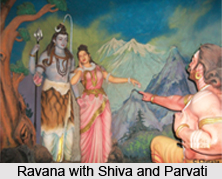 Legend of Ravana, Shiva and Parvati states about the story where Ravana was punished by Lord Shiva for uprooting Kailasa. According to the legend once Ravana, the king of Lanka went for a battle to defeat Lord Kuber, the god of wealth. He succeeded in his mission and won the battle. During his return Ravana approached a place called Sravana, where Kartikeya was born. He climbed upon a hill from where he could enjoy the imposing sight of the beautiful garden. The Puspaka plane was diverted towards it. However, when he reached closed to the garden the plane could not move further after certain limit. At that place he met with a tawny coloured, monkey faced and powerful dwarf known as Nandikesvara. He was an attendant of Lord Shiva. Ravana asked him about the reason for the non-movement of the plane. Nandikesvara told him that when Lord Siva and Goddess Uma were engaged in conjugal pleasure no one was allowed to entry to the place. Hearing this Ravana was enraged and he laughed mockingly at Nandikesvara who in returned cursed him that Ravana`s abode would be destroyed by the monkeys. Ravana became enraged and tried to uproot Kailasa Mountain. He opened his arms and began lifting the mountain and was somewhat successful in his mission. Goddess Uma out of fear clung to Shiva. The Lord soon realised the reason and pressed the mountain firmly thus, pressing him down beneath it.
Legend of Ravana, Shiva and Parvati states about the story where Ravana was punished by Lord Shiva for uprooting Kailasa. According to the legend once Ravana, the king of Lanka went for a battle to defeat Lord Kuber, the god of wealth. He succeeded in his mission and won the battle. During his return Ravana approached a place called Sravana, where Kartikeya was born. He climbed upon a hill from where he could enjoy the imposing sight of the beautiful garden. The Puspaka plane was diverted towards it. However, when he reached closed to the garden the plane could not move further after certain limit. At that place he met with a tawny coloured, monkey faced and powerful dwarf known as Nandikesvara. He was an attendant of Lord Shiva. Ravana asked him about the reason for the non-movement of the plane. Nandikesvara told him that when Lord Siva and Goddess Uma were engaged in conjugal pleasure no one was allowed to entry to the place. Hearing this Ravana was enraged and he laughed mockingly at Nandikesvara who in returned cursed him that Ravana`s abode would be destroyed by the monkeys. Ravana became enraged and tried to uproot Kailasa Mountain. He opened his arms and began lifting the mountain and was somewhat successful in his mission. Goddess Uma out of fear clung to Shiva. The Lord soon realised the reason and pressed the mountain firmly thus, pressing him down beneath it.
Ravana soon realised his mistake and began adorning Shiva. For thousand years he kept on weeping and recited hymns in honour of the Lord. He prayed to him incessantly. Finally Lord Shiva was pleased with his devotion. He thus, pardoned him and released him.
Iconography of Ravana, Shiva and Parvati
The scene of Ravana lifting Kailasa has been beautifully depicted in the Kailasa temple at Ellora in a panel. It depicts the king of Lanka putting all his efforts to lift Kailasa Mountain and Lord Shiva, Goddess Uma and other attendants on it. Another such depiction can be seen in Belur in Karnataka. The Kailasa Mountain here has been intricately carved with a large number of deities and other animals from the elephants down to the snake on it. On the apex of the beautifully carved mandapa Shiva and Parvati have been portrayed seating with several deities singing hymns in praise of the divine couple. Ravana is depicted kneeling down below the mountain in an effort to lift it.




















